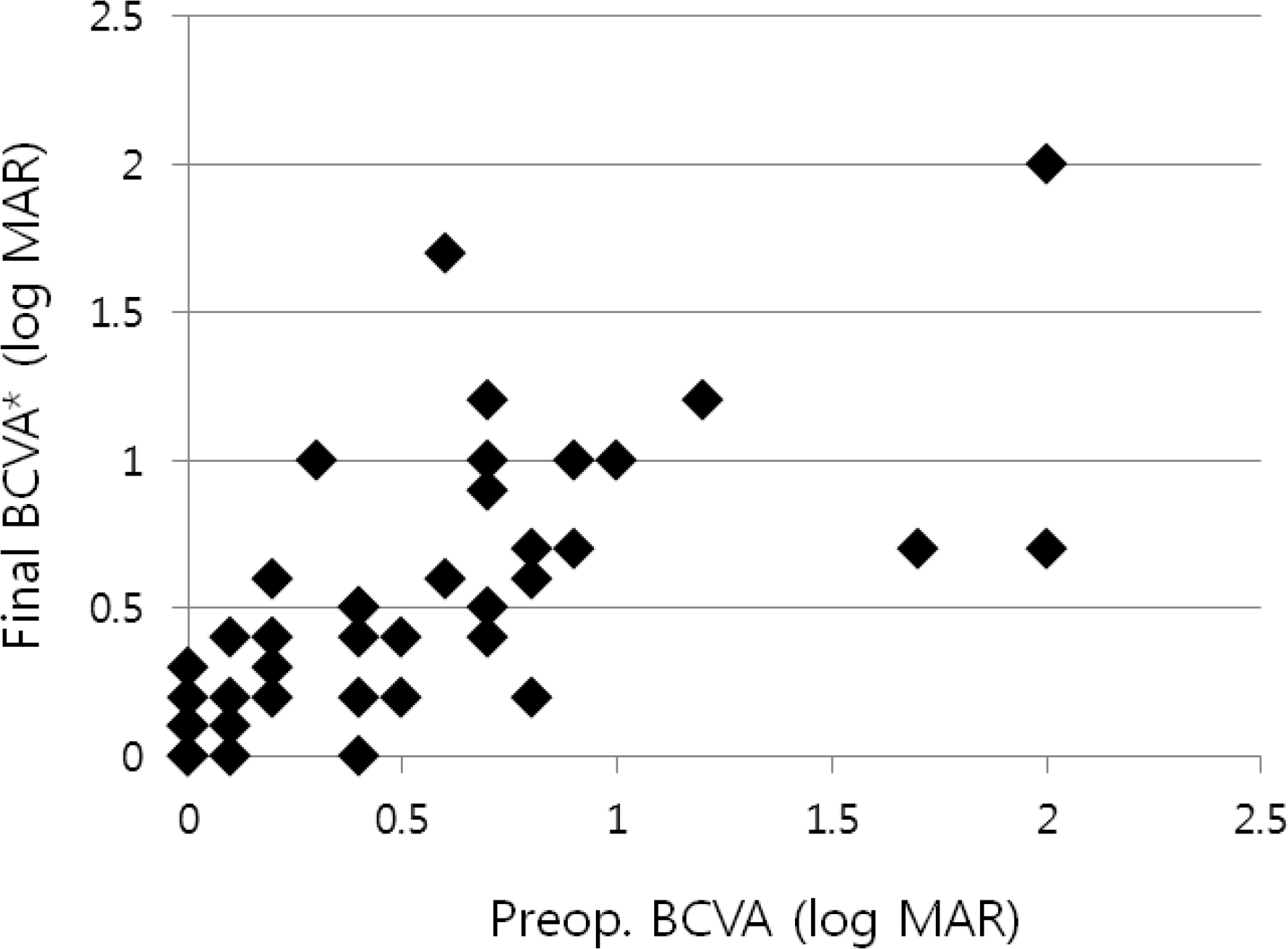Abstract
Purpose
To evaluate the clinical outcomes of secondary intraocular lens (IOL) implantation in eyes that underwent pars plana vitrectomy and lens removal due to ocular trauma.
Methods
We retrospectively investigated 40 vitrectomized aphakic eyes that had received secondary IOL from March 2005 to January 2012. Various parameters including pre- and postoperative best corrected visual acuity (BCVA) were reviewed.
Results
Incidence was higher in males (n = 35, 89.7%) and highest in the 6th decade of life (n = 13, 33.3%). Mean preoperative refractive error was +9.99 ± 2.80 D in spherical equivalent, and astigmatism was 1.80 ± 1.73 D. Mean BCVA (log MAR) was 0.53 ± 0.51 preoperatively and 0.54 ± 0.46 at 6 months postoperatively. Postoperative refractive error was −1.28 ± 1.40 D and the astigmatism was 2.54 ± 1.52 D. The difference between the target and postoperative refractive error was a myopic shift of −0.63 ± 1.44 D. Postoperative BCVA had no significant correlation with preoperative factors other than preoperative BCVA (p < 0.001). The most common complication was temporarily increased IOP in 4 eyes. Choroidal detachment, recurrence of retinal detachment, bullous keratopathy, and cystoid macular edema were each found in 1 eye. IOL dislocation was corrected with reoperation in 2 eyes.
Go to : 
References
1. Song MH, Kim JW, Chung SK. . The statistical observation of ocular injury. J Korean Ophthalmol Soc. 2009; 50:580–7.

2. May DR, Kuhn FP, Morris RE. . The epidemiology of serious eye injuries from the United States Eye Injury Registry. Graefes Arch Clin Exp Ophthalmol. 2000; 238:153–7.

3. Berler DK, Friedberg MA. Scleral fixation of posteriorchamber intraocular lens implants combined with vitrectomy. Trans Am Ophthalmol Soc. 1991; 89:215–34.
4. Mietz H, Konen W, Heimann K. Visual outcome of secondary lens implantation after trauma or complicated retinal detachment surgery. Retina. 1994; 14:212–8.

5. Ryan EH Jr, Gilbert HD. Lensectomy, vitrectomy indications, and techniques in cataract surgery. Curr Opin Ophthalmol. 1996; 7:69–74.

6. Díaz Lacalle V, Orbegozo Gárate FJ, Martinez Alday N. . Phacoemulsification cataract surgery in vitrectomized eyes. J Cataract Refract Surg. 1998; 24:806–9.
7. Mei H, Xing Y, Yang A. . Suprachoroidal hemorrhage during pars plana vitrectomy in traumatized eyes. Retina. 2009; 29:473–6.

8. Hoffer KJ. Ultrasound velocities for axial eye length measurement. J Cataract Refract Surg. 1994; 20:554–62.
9. Chuang LH, Lai CC. Secondary intraocular lens implantation of traumatic cataract in open-globe injury. Can J Ophthalmol. 2005; 40:454–9.

10. Cohen KL. Inaccuracy of intraocular lens power calculation after traumatic corneal laceration and cataract. J Cataract Refract Surg. 2001; 27:1519–22.

11. Rowsey JJ, Hays JC. Refrective reconstruction for acute eye injurys. Ophthalmic Surg. 1984; 15:569–74.
12. Navon SE. Topography after repair of full-thickness corneal laceration. J Cataract Refract Surg. 1997; 23:495–501.

13. Lamkin JC, Azar DT, Mead MD, Volpe NJ. Simultaneous corneal laceration repair, cataract removal, and posterior chamber intraocular lens implantation. Am J Ophthalmol. 1992; 113:626–31.

14. Rubsamen PE, Irvin WD, McCuen BW 2nd. . Primary intraocular lens implantation in the setting of penetrating ocular trauma. Ophthalmology. 1995; 102:101–7.

15. Bowman RJC, Yorston D, Wood M. . Primary intraocular lens implantation for penetrating lens trauma in Africa. Ophthalmology. 1998; 105:1770–4.

16. Larsen JS, Syrdalen P. Ultrasonographic study on changes in axial eye dimensions after encircling procedure in retinal detachment surgery. Acta Ophthalmol (Copenh). 1979; 57:337–43.

17. Abu El Einen KG, Shalaby MH, El Shiwy HT. Immersion B-guided versus contact A-mode biometry for accurate measurement of axial length and intraocular lens power calculation in siliconized eyes. Retina. 2011; 31:262–5.

18. Kunavisarut P, Poopattanakul P, Intarated C, Pathanapitoon K. Accuracy and reliability of IOL master and A-scan immersion biometry in silicone oil-filled eyes. Eye (Lond). 2012; 26:1344–8.

19. Hayashi K, Yoshida M, Hayashi H. Corneal shape changes after 2.0-mm or 3.0-mm clear corneal versus scleral tunnel incision cataract surgery. Ophthalmology. 2010; 117:1313–23.

20. Duffey RJ, Holland EJ, Agapitos PJ. . Anatomical study of trassclerally sutured intraocular lens implantation. Am J Ophthalmol. 1989; 108:300–9.
21. Kaynak S, Ozbek Z, Pasa E. . Transscleral fixation of foldable intraocular lenses. J Cataract Refract Surg. 2004; 30:854–7.

22. Rho KH, Park MJ, Choi KS, Lee SJ. Scleral fixation of foldable intraocular lenses using injector. J Korean Ophthalmol Soc. 2007; 48:167–71.
24. Jain S, Azar DT, Pineda R. Management of astigmatism after corneal trauma. Int Ophthalmol Clin. 2002; 42:47–55.

25. Troutman RC. Microsurgical control of corneal astigmatism in cataract and keratoplasty. Trans Am Acad Ophthalmol Otolaryngol. 1973; 77:OP563–72.
26. Bergren RL. Four-Point fixation technique for sutured posterior chanber intraocular lenses. Arch Ophthalmol. 1994; 112:1485–7.
27. Kim HK, Kim JM, Kim SS, Kim HS. New technique of implantation of posterior chamber intraocular lens in the absence of capsular support: 4 step test for sulcus fixation. J Korean Ophthalmol Soc. 1991; 32:1057–67.
28. Ahn KJ, Yu HG, Chung H. . Transscleral fixation of a foldable intraocular lens in aphakic vitrectomized eyes. J Cataract Refract Surg. 2003; 29:2390–6.

29. Hotta K. Postoperative refractive error of secondary intraocular lens implantation after simultaneous vitrectomy and lensectomy. Ophthalmic Surg Lasers Imaging. 2007; 38:336–8.

Go to : 
 | Figure 1.Preoperative and postoperative visual acuity had significant correlation (r = 0.687,p < 0.001) after secondary intraocular lens implantation in vitrectomized aphakic eye due to trauma (*best corrected visual acuity). |
Table 1.
Baseline characteristics
Table 2.
Changes of visual acuity, refractive error, and astigmatism after secondary intraocular lens implantation in vitrectomized aphakic eye due to trauma




 PDF
PDF ePub
ePub Citation
Citation Print
Print


 XML Download
XML Download